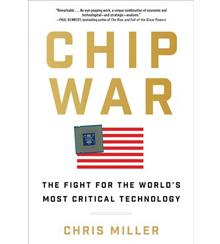A new look at the microchip’s midlife crisis
Chris Miller’s Chip War chronicles the rise in our global reliance on semiconductors.

Chip War: The Fight for the World’s Most Critical Technology
by Chris Miller, Scribner, 2022
The global computer chip industry is more interesting than one might think, for two interconnected reasons. First, manufacturing computer chips has become a mind-bogglingly complicated process that has pushed the world’s most talented engineers to the edge of their capabilities; it is now so difficult to make further advances in the technology that very few firms have the knowledge and the resources to be able compete in the market. Second, with an annual output of around US$600 billion, production is extremely concentrated for a major global industry. Incredibly, most of the world’s semiconductors are produced on the small island of Taiwan. This puts the industry in a very delicate balance. The ubiquity of these chips in modern life—you’re using billions of transistors while reading this article on your phone or computer—means that the health of the global economy rests on the maintenance of that balance.
Another noteworthy facet of the industry is how quickly it has developed. It has been less than a human lifetime since a US firm, Bell Labs, announced the invention of the first transistor, in which an electrical current could be amplified and switched on or off using three pieces of silicon. It was another decade before scientists realized that multiple transistors could be assembled on the same sheet, creating an integrated circuit. Such circuits soon became known as “chips,” as they were each chipped off a larger piece of silicon. Since then, chip designers have continually sought to cram more and more computing power onto each chip. In 1975, a member of the first generation of chip designers, Gordon Moore, famously suggested that the number of transistors on each integrated circuit would double every two years. Meeting this benchmark has become a measure of the performance of the industry.
For decades, companies such as Intel and Samsung plowed billions of dollars into research and development to design more powerful chips, and they were rewarded with enormous consumer, business, and military demand for their increasingly sophisticated electronic goods. But maintaining the exponential growth that Moore predicted has become harder as engineers have approached the limits of the laws of physics. For example, one of the technology’s foundational elements has been lithography, or the practice of using light to print or remove material to shape the chip. By the early 2000s, chips had become so small that even ultraviolent light was too big to deliver the precision required.
In Chip War, a book that skillfully weaves together the scientific, economic, and political history of computer chips, its author, Chris Miller, explains that the Dutch company quite literally at the cutting edge of lithography, ASML, began to explore the possibility of using extreme ultraviolet light (EUV) in the mid-1980s. EUV has a wavelength of 13.5 nanometers, or approximately 15 times as narrow as regular UV. The process is almost too complicated to be believed. Generating the light itself involves shooting a tiny ball of tin that is moving speedily through a vacuum with a laser to turn it into liquid metal that is many times hotter than the surface of the sun. This process is done, according to Miller, 50,000 times a second to produce enough EUV light to manufacture chips. Each of the lasers alone requires almost half a million components, and each EUV machine costs US$100 million, making it “the most expensive mass-produced machine tool in history.”
The book provides a compelling perspective on the geopolitical implications of chip manufacturing. Because the production of chips has become so specialized and requires such expensive equipment, the only way to make money in the industry is to produce in huge volumes. And here, one company, Taiwan Semiconductor Manufacturing Company (TSMC), has cornered the market. TSMC alone produces around 85% of the global supply of the thinnest, most advanced chips, the sort that power smartphones and other devices.
Because the production of computer chips has become so specialized and requires such expensive equipment, the only way to make money in the industry is to produce in huge volumes.
Taiwan’s dominance of chip manufacturing—and by extension the success of TSMC—owes itself equally to political and business foresight. The former, as Miller explains, came from former economy minister K.T. Li, who saw that hosting assembly plants for US companies could reduce the risk of aggression from the Chinese mainland. For its American partners, Taiwan offered much lower labor costs and a straightforward business environment. The first chip assembly facility, owned by Texas Instruments (TI), opened in Taiwan in 1969. Another was operated by Morris Chang, a former executive at TI, whom Li brought to Taiwan in the 1980s to develop its domestic chip industry. At the time, most leading chip companies designed and made their own chips. Chang realized this position was going to become untenable because smaller transistors were going to require much more expensive manufacturing tools.
Both Li and Chang have been proven spectacularly right. With TSMC footing the bill for the equipment, the firm has been able to build a “grand alliance” of firms that design chips, manufacture components, and sell IP, all reliant on TSMC but none competing on its core business. Chang’s instincts have also remained sharp. His successor as CEO responded to the global financial crisis by cutting costs and personnel. But Chang, who was TSMC’s chair, wanted the company to be the main manufacturer of the chips in Apple’s iPhones, the contract for which belonged to Samsung. He sacked his successor, rehired the workers, and embarked on a huge R&D spending spree. It wasn’t long before Apple switched from Samsung to TSMC.
Chang’s determination to continue to innovate was also a matter of survival. China’s focus on building its own domestic semiconductor industry has become increasingly intense. It has tried different strategies: building a national champion, in the manner of TSMC, by hiring lots of foreign PhDs and granting the new entity big tax breaks; and buying existing foreign entities to gain ownership of their IP. Neither has been particularly successful, to the extent that Miller believes China has realized that building a non-US supply chain is impossible. Instead, it is trying to focus on areas that do not require the most advanced technology and reduce its reliance on US imports.
All of which means that TSMC now has several major Chinese companies—including Huawei, Tencent, and Alibaba—among its biggest customers, as well as Apple and Amazon. The world’s reliance on this one series of factories, on a single island, whose sovereignty is disputed by the globe’s two economic superpowers and which is located in an area of regular seismic activity, is anxiety-inducing. The Taiwan government likes to think of its chip industry as a sort of nuclear deterrent. This has worked insofar that it has kept US attention focused on the island. But it has also made the country’s contents more attractive to its next-door neighbor.
Author profile:
- Mike Jakeman is a freelance journalist and has previously worked for PwC and the Economist Intelligence Unit.



